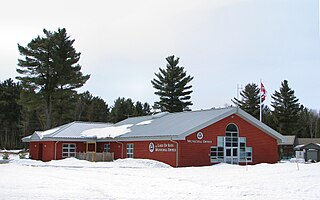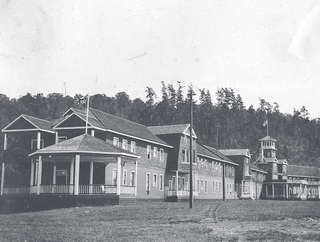
Huntsville is a town in Muskoka district, Ontario. It is located 215 kilometres (134 mi) north of Toronto and 130 kilometres (81 mi) south of North Bay. Of the three major Muskoka towns (the others being Gravenhurst and Bracebridge, it is the largest in both population and land area.

The Ontario Northland Railway is a Canadian railway operated by the Ontario Northland Transportation Commission, a provincial Crown agency of the government of Ontario.

The District Municipality of Muskoka, more generally referred to as the District of Muskoka or Muskoka, is a regional municipality in Central Ontario, Canada. It extends from Georgian Bay in the west, to the northern tip of Lake Couchiching in the south, to the western border of Algonquin Provincial Park in the east. A two-hour drive north of Toronto, it spans 6,475 km2 (2,500 sq mi). It has some 1,600 lakes, making it a popular cottaging destination.

Lake of Bays is a township municipality within the District Municipality of Muskoka, Ontario, Canada. The township, situated 193 kilometres (120 mi) north of Toronto, is named after the Lake of Bays. During the 2016 census, the township had a population of 3,167 and encompassed 677.91 square kilometres (261.74 sq mi) of land.
Chippawa is a community located within the city of Niagara Falls, Ontario.

Canada Steamship Lines (CSL) is a shipping company with headquarters in Montreal, Quebec, Canada. The business has been operating for well over a century and a half.

RMS Segwun is the oldest operating steam driven vessel in North America, built in 1887 as Nipissing to cruise the Muskoka Lakes in the Muskoka, Ontario, Canada, a resort area with many lakes and rivers. Early in the 20th century, Muskoka was poorly served by roads. Vacationers were transported to lodges, or private cottages, via a fleet of steamships. Segwun is the oldest of only three ships in the world still carrying the status of Royal Mail Ship, and the only steamer.

The Toronto, Hamilton and Buffalo Railway was a railway based in Hamilton that ran in Southern Ontario from 1892 to 1987. It never reached the other two cities in its name although it had branch lines extending to Dunnville and Port Maitland.

The Northern Railway of Canada was a railway in the province of Ontario, Canada. It was the first steam railway to enter service in what was then known as Upper Canada. It was eventually acquired by the Grand Trunk Railway, and is therefore a predecessor to the modern Canadian National Railway (CNR). Several sections of the line are still used by CNR and GO Transit.

Bigwin Island is an island in the municipality of Lake of Bays, District Municipality of Muskoka in Central Ontario, Canada. It the largest island on Lake of Bays.

Peninsula Lake in the District Municipality of Muskoka, is one of the (North) Muskoka Lakes.
The Ilwaco Railway and Navigation Company operated a 3 ft narrow gauge railroad that ran for over forty years from the bar of the Columbia River up the Long Beach Peninsula to Nahcotta, Washington, on Willapa Bay. The line ran entirely in Pacific County, Washington, and had no connection to any outside rail line. The railroad had a number of nicknames, including the "Clamshell Railroad" and the "Irregular, Rambling and Never-Get-There Railroad."

Although most railways of central and eastern Canada were initially built to a 5 ft 6 in broad gauge, there were several, especially in Atlantic Canada and Ontario, which were built as individual narrow-gauge lines. These were generally less expensive to build, but were more vulnerable to frost heaving because vertical displacement of one rail caused greater angular deflection of the narrower two-rail running surface. Most of the longer examples were regauged starting in the 1880s as the railway network began to be bought up by larger companies.

The history of commercial passenger shipping on the Great Lakes is long but uneven. It reached its zenith between the mid-19th century and the 1950s. As early as 1844, palace steamers carried passengers and cargo around the Great Lakes. By 1900, fleets of relatively luxurious passenger steamers plied the waters of the lower lakes, especially the major industrial centres of Chicago, Milwaukee, Detroit, Cleveland, Buffalo, and Toronto.

Lake of Bays is a large lake in the District Municipality of Muskoka in Central Ontario, Canada. It is located almost entirely in the Township municipality of Lake of Bays, which is named after the lake, with the exception of the southwest arm of the lake which is in the Town of Huntsville. Ontario Highway 35 runs north and east of the lake.
SS Bigwin is a small steamship ferry that plies the waters of Lake of Bays in Muskoka area of Ontario, Canada.

The Bay of Quinte Railway was a short-line railway in eastern Ontario, Canada. It was formed as the Napanee, Tamworth and Quebec Railway (NT&QR), chartered in 1878 by Edward Rathbun and Alexander Campbell, with plans to run from Napanee through Renfrew County and on to the Ottawa Valley. Lacking funding from the governments, development never began.

The Wawa Hotel was a large summer resort hotel located at Norway Point on Lake of Bays, in Ontario, Canada. Constructed in 1908, it was entirely destroyed by a fire on August 19, 1923. The name "Wawa" is a native Canadian word for "wild goose".

The Royal Muskoka Hotel was a luxury summer resort hotel that operated from 1901 to 1952 on Lake Rosseau in Ontario's Muskoka region. The hotel was built by the Muskoka Lakes Navigation Company and was serviced by its steamers. During its first three decades, the Royal Muskoka was Ontario's preeminent summer resort and attracted guests from the upper echelons of Canadian and American society. After the onset of the Great Depression, the hotel struggled through the 1930s. During World War II it saw a mild revival as vacations in Europe were no longer possible, but following the war its problems resumed. In the early hours of 18 May 1952, a fire razed the entire structure.


















